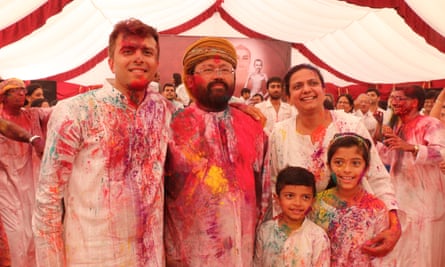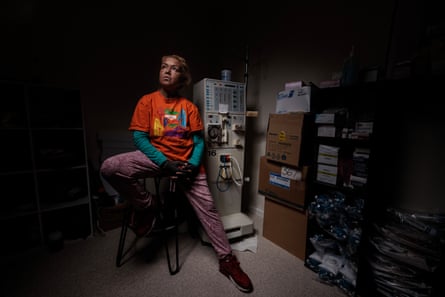‘It’s only because of your son that my daughter’s living’: overcoming the cultural barriers to organ donation
When doctors told Mili Udani there was nothing more they could do to treat her seven-year-old son Deyaan’s brain haemorrhage, her “world came crashing down”. Only a week earlier they had been enjoying a holiday to see family in Mumbai when he began complaining about headaches.
After three doctors declared Deyaan brain dead, Udani’s cousin asked her if she had thought about organ donation. The question suddenly brought back a memory from a few weeks earlier.

Deyaan had come home from his school’s Road and Safety Week wanting to look at Udani’s driving licence to see if she had the symbol showing she was registered as an organ donor. He told her that when he grew up, if he got the chance, he would donate his organs.
Udani wanted to honour what she considered her son’s last wish. However, her extended family, including her husband, did not want the organs donated – in part due to fears it could affect the process of rebirth they believed in as Jains. She was troubled by the family’s opposition, but her resolve was affirmed consulting her guru who told her he was with her.
“Once we said ‘yes’, the coordinator came up to me and she was so emotional. And she said, ‘I just want to let you know that the recipient is also seven years old,” Udani says.
A year later, Udani met the mother of the little girl who was saved by her son’s heart.
“It was just heartbreaking to meet that mother. She was so thankful and grateful. In our culture bowing down and touching someone’s feet is the highest form of respect. She fell to my feet and said it’s only because of your son that my daughter’s living.”
Cald donors make up only 15%
Udani’s family is in the minority to have had a conversation about organ donation. Organ donation rates are disproportionately low in culturally and linguistically diverse (Cald) communities, which account for just 15% of the more than 500 organ donations made in 2023. This is about 10 percentage points below their share of the population.
Research from New South Wales has found Cald families are both less likely to be asked to donate the organs of their family member, and less likely to give consent if asked. Dr Angela Webster, one of the researchers, talks about the process of getting consent for organ donations as a series of barriers that must be overcome, which can be complicated by a number of intersecting factors behind lower donation rates.
Donation rates are significantly higher in cases like Udani’s, where it is known that family members wanted to be a donor. But people from Cald backgrounds are less likely to have discussed or decided about organ donation.
Cald communities are also less likely to be living near the better-resourced hospitals in the centre of cities where most donations take place. This affects both the potential pool of donors, as well as whether the hospital will have specialists and translators available to talk to families about potential donation.
“The Royal Prince Alfred in central Sydney has a much higher donation rate than Liverpool hospital, for instance, even though they might seem to serve similar numbers of people,” says Dr Webster.
Some diseases also disproportionately affect Cald communities, which can be a barrier to donation. First Nations Australians and those from Pacific Island, Middle Eastern or South Asian heritage have a higher risk of developing diabetes, for instance.
There are also language barriers and cultural barriers, which can be especially hard to overcome when donation is time-sensitive, or there aren’t translators around.
Dr Helen Opdam, the national medical director with the Australian Organ and Tissue Authority, known as Donate Life, says it is important that all Australians have a right to accurate information about end-of-life choices, including the important decision of whether to donate their organs; however, access to information is not equal, with culturally and linguistically diverse communities often missing out.
Opdam says it is also important to increase donation in these communities because the immune systems need to be compatible between donor and recipient to prevent rejection, particularly for kidney donations.
“So the more diverse people we can have become donors from different cultural backgrounds, that will certainly help with the matching of similar people with that same genetic background that influences the immune system and the matching up of the donor organs and recipients,” Opdam says.
after newsletter promotion
‘Nothing like the freedom of a transplant’
The government has announced almost $400,000 in grants supporting grassroots engagement with culturally and linguistically diverse (Cald) communities on the issue.
As part of the Organ and Tissue Authority’s community awareness grants, 11 community organisations will share in the funds to deliver digital resources, content, and host DonateLife Week events for Australia’s culturally and linguistically diverse communities, multicultural and faith groups.
The assistant minister for health and aged care, Ged Kearney, says “Australia is a diverse and multicultural country. These grants will help encourage conversations around organ and tissue donation with Cald communities in their own voices.”
One of the grants has gone towards a free public concert featuring performances by young Cald artists, a recipient-donor duo, Indigenous rapper Little G, and headlined by The Transplants, a rock band led by Paulie Stewart in which all members have undergone organ transplants.
Little G, born Gina Chrisanthopoulos, spent her entire high school career carrying around a pager which would tell her when a kidney was ready to be donated.
Chrisanthopoulos was born with urinary reflux, a condition in which the kidneys are damaged by the backward flow of urine into the kidney, but it wasn’t discovered until age 11 when she was taken to a specialist who was bowled over by her blood pressure of 260 over 160.

Without a kidney donation, she went through high school spending her lunchtimes in the first aid room on dialysis, a machine that removes waste products from the blood when your kidneys are unable to, as well as before school, when she got home in the afternoon and before going to sleep.
That is until Chrisanthopoulos getting ready to go out on the night of her 18th birthday, when her pager went off. “The excitement of getting that beeper – because I took that every day with me from year 7 upwards till I got my transplant. And it just didn’t seem real.”
Chrisanthopoulos remembers smiling on the way to the operating theatre and “having a mum and dad there watching me”.
The transplant came at the perfect time, Chrisanthopoulos says, allowing her to study acting and hip-hop, and go on to have a career performing as Little G and dancing both solo and as part of musical groups. For the 16 years the kidney transplant lasted, she says: “I never stopped working. I just lived life to the fullest. I did everything that came my way.”
However, when the transplant started failing in 2013 Chrisanthopoulos had to go back on dialysis and has since been limited in her career as a performer. She has been waiting for a second transplant for more than 10 years now.
Instead of the four sessions, seven days a week receiving dialysis through her stomach as she did when she was a child, Chrisanthopoulos now receives the same procedure through her arm (hemodialysis) three days a week, but four to five hours per session.
“Either way they’re exhausting. [There’s] nothing like the freedom of a transplant I tell you.”